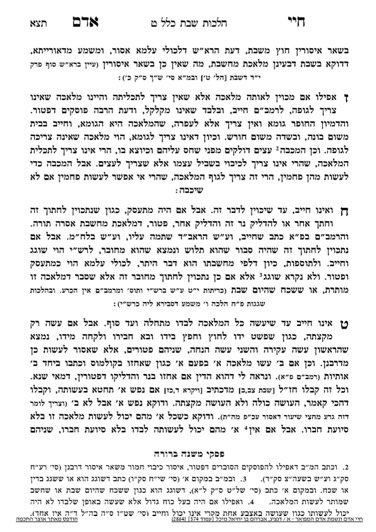We are continuing in siman 7. We learned (shiur S277) that the Ran says that melacha she’eina tzricha legufah is more chamur than an average derabanan, because it is so similar to the issur deoraysa. One can see two people digging a hole; one person will be transgressing an issur deoraysa and the other is transgressing an issur derabanan. Therefore, Chazal did not give melacha she’eina tzricha legufa the leniencies of a standard issur derabanan. We will see a few examples of these chumros.
- The halacha is that if it is bein hashmashos, and a person did not yet accept Shabbos (neither by their own volition nor through the tzibbur), one is permitted to perform issurei derabanan for the purpose of a mitzvah. However, one cannot perform a melacha she’eina tzricha legufah for the purpose of a mitzvah. For example, if one left tzitzis on a tree, they would be permitted to retrieve it during bein hashmashos. However, a melacha she’eina tzricha legufah would remain assur. (Siman 342)
- If a person is a choleh she’ein bo sakanah, where they are confined to bed but not in life-threatening danger, we pasken that for sakanas eiver, danger to a limb, a Jew can perform any issur derabanan. If there is no danger whatsoever, just that the person is confined to bed, they may perform issurei derabanan with a shinui. The case in question is extinguishing a candle for the benefit of the sick person. The Gemara says that it is muttar for a choleh she’yeish bo sakanah, and assur for a choleh she’ein bo sakanah. The Mishnah Berurah points out that this leniency does not apply to extinuishing even though by definition it is a melacha she’eina tzricha legufa, and only derabannon, because melacha she’eina tzricha legufa is more chamur than a regular derabannon. (Siman 328 and 278)
- We have a concept of safeik derabanan lekulah. Nevertheless, the Shaar Hatziyun writes that we do not apply this concept to melacha she’eina tzricha legufah.
- The case under discussion in the Ran is a question of amira l’akum on a derabanan (known as a shvus d’shvus). It is muttar to perform amira l’akum in this case in a situation of hefsed. Nevertheless, one cannot perform amira l’akum on a melacha she’eina tzricha legufah, because we are machmir. Therefore, for example, if there is a fire which poses no danger to humans, one cannot ask a non-Jew to extinguish it. If there is danger to life, it is obviously muttar. One can hint to a non-Jew. (Siman 334)



